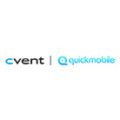This is a sponsored post written by Grace Cheung, Marketing Coordinator at QuickMobile. More information about Event Manager Blog’s sponsored posts.
While event apps are ubiquitous at events, they are typically only used as a paper program replacement, or a scheduling aid. But they can be a lot more.
If you have the time and the budget, you can take your event app beyond their foundational uses. Most event apps have capabilities such as polling, scheduling, networking, and communication tools. By taking advantage of these, you can reach a wider audience, gather important data, and overall get a deeper and more controlled understanding of what goes on at your event.
Here are some examples of event apps that were repurposed by planners – some pre-planned, and others on-the-spot – to better fit the goals and flow of their event.
##abovethefold##
Make Quizzes and Test Your Audience
Most event planners only use audience surveys, either paper or digital, at the end of sessions and keynotes. Audience feedback is an excellent source of information, but you can extend the usage of polls so that feedback benefits both planners and speakers.
Savvy planners have used polling functionality within event apps to allow speakers to run ‘pop quizzes’ during their sessions. It’s not as scary as in school – typically speakers just put up questions that supplement their presentation. This adds an interactive element to the session, and acts as a way of gauging the audience. It can also help audiences conceptualize what they are learning, thus creating a more successful learning environment overall.
There is software that will do this specifically, but you can set up the survey component of your event app to do the same thing. Simply input the speaker’s quizzes in your event app’s back end, and sync them to the run time of that session. Speakers will then just have to direct attendees to the quiz in the event app that they’ll already have on hand.
Create Games for Better Learning and Participation
For some, quizzes of any sort are a source of fear. But when paired with gamification, your polling functions can be used to learn without unnecessary stress.
Gamification inspires attendees to perform certain actions because they can gain points that contribute to an overall score. Typically, event planners use social actions such as posting on Twitter, leaving comments, and visiting exhibitor booths.
Consider applying gamification to your quizzes (see example 1 above) to urge attendees to continually challenge the questions and test their knowledge. Getting small rewards, even in-game points, in exchange for their efforts encourages people to return to the task. This is how learning apps like Duolingo operate, and explains why that polyglot Owl is so addicting.
Build Community with an Internal Social Forum
If your event has sensitive information, or you’d prefer for attendees to keep their posts off public social media platforms, use your app as an alternative.
The event app’s notification feed can be setup to display different types of posts – user-generated, organizer-prepared, even photos and announcements – and attendees can also comment and interact through it. In addition, use one-on-one messaging systems paired with searchable attendee lists to create an instant messaging system with pre-populated contacts.
Be sure to turn on password-protected access if your intent is to keep internal communications private. You can also create separate ‘events’, if you have a multi-event container, and lock them to specific users in order to create subforums where attendees can interact and access information securely.
Take Attendance for Safety and Accountability
At some conferences, it’s imperative for organizers to know not only that attendees attended a session, but that they stayed for the whole session.
This could be for a variety of reasons, but in those cases, it’s much easier to digitize the attendance-taking process. You can do this in a few ways. Setup quizzes or session check-in so that attendees can only do it at a specific time – for example, 10 minutes during the session, or the last few minutes. Your speakers will have to notify attendees of the opportunity window, but this is a good way to ensure that attendees are in sessions and paying attention.
Alternatively, if you have location technology set up for your app, you can use physical checkpoints to ensure that attendees visit certain locations at your event, at specific times.
Outside of sessions, planners can also work with their support teams to set up the event app’s registration capabilities for impromptu safety check-ins. Using the registration function, which is easier to locate and will already be familiar to attendees, allows for a faster response.
Use Proximity Technology for Pseudo-AR
Typically when we talk about AR, we’re referring to technology like the Pokemon Go game, or IKEA’s furniture app, where images are overlaid onto the surrounding environment via a smartphone. But even if you don’t have the resources to commission a full AR experience, or think that too much could overwhelm your event, you can create a lighter version of it by syncing timely content to the goings on of your event.
One way to do this is to use more generic location triggers. Set up beacons in doorways, at specific booths, or in rooms. It can be very satisfying for an attendee to walk into a room and receive an appropriate notification, or a video alert, especially if the content fits with the theme of the event.
You can also have a staff member send out prepared notifications in time with a presentation or keynote. Because event apps update instantly so long as they’re connected to WiFi, you can simulate a fully-automated AR experience by pushing out photos or documents to attendees as the speaker refers to those specific points.
In Conclusion
Your event app can and should do more.
Whether you need a learning tool, a communicative device, or want to add to the experience of your event, repurposing your event app allows you to get more out of your technology.
Take advantage of your event app’s flexible functionalities, and adjust it to fit what you need for your event. There’s no need to source additional software when your event app can do just fine. You might even find that consolidating your tech stack and utilizing the tools you already have ultimately saves you time, energy, and budget.






